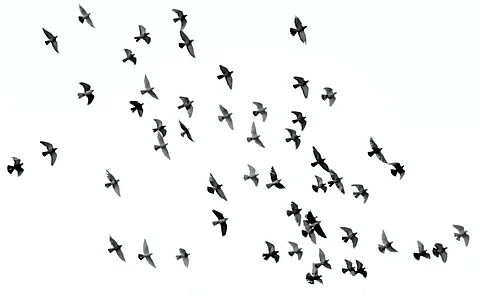
- Home
- न्यूजग्राम
- NewsGram USA
- India
- World
- Politics
- Entertainment
- Culture
- Lifestyle
- Economy
- Sports
- Sp. Coverage
- Misc.
- NewsGram Exclusive
- Jobs / Internships

Kashmir's passionate affair with migratory birds is coming to an end as the winged marvels of nature are packing bags to return home after a season's stay in the Valley's hospitable climate. The Valley has attracted and mesmerized the whole world, and these European friends are no exception. This year, 20 new and rare species have joined the party, exciting scores of bird watchers in the Valley. Four lakh migratory birds from Central Asian Republics, Russia, Siberia, and Turkey escape the freezing temperatures of their homelands. Few species fly in from the Philippines, Eastern Europe, and Japan.
The Greylag geese visit in largest numbers. | Wikimedia Commons
Their arrival is marked with cackles and coos and exotic colours in the sky. They fly in by mid-October and leave for their homes by March almost with arithmetical accuracy. Along with these migratory birds, 'birds of passage' also join this annual gathering in the Himalayas. Birds of passage like the Sandhill crane come to Kashmir from the Indian Plains before going back south in spring. These avian guests bring life to the lethargic winter days of Kashmir. The new guests this year are — Sharpe Tailed Sandpiper, Glossy Ibis, Dunlin, Red-Necked Phalarope, Yellow Hammer, Tundra Swan, Black-Tailed Godwit, Spotted Redshank, Kentish Plover, Pacific Golden Plover, Terrek sandpiper, Curlew Sandpiper, Ruff, Common Redshank, Common Greenshank, Jack Snipe, Pin Tailed Snipe, Little Stint, among others.
Kashmir houses 24 wetlands. Shalbough, located in the Ganderbal district is the biggest wetland spread over 16 sq km while the most famous Hokersar wetland on the city outskirts is around 13.5 sq km. Hygam wetland in North Kashmir is spread across 9 sq km. Another important wetland is Chatlam, located in South Kashmir's Pampore. Other habitation spots include the lakes — Dal, Mansbal, and Wular, and agricultural lands and orchards. These areas sustain a large population and variety of immigrants, and also give them a breeding ground for a few months. Presently, Dal Lake has over 1 lakh birds, Hokesar and Hygam reserve has 1 lakh birds each, Shalbough bird reserve has 50,000, Chatlum has 20,000, and Wular Lake has 30,000 birds.
One of the new guests this year are – Yellowhammer, etc. | Wikimedia Commons
Bird migration is nature's finest example of an inner compass that guides one through life. Each species independently comes together. The eldest pilot bird of the flock navigates her way through the sky and the rest follow. They create formations and highly disciplined patterns in the sky depending upon the direction of wind and climate of land, all through instinct. Brahminy duck, Tufted duck, Gadwall, Garganey, Greylag goose, Mallard, Common Merganser, Northern Pintail, Common Pochard, Ferruginous Pochard, White-eyed Pochard, Red-crested Pochard, Ruddy Shelduck, Northern Shoveler, Common Teal, Ergets, Wigeons, Coots, Little Cormorants, etc are the most common gracious visitors.
The Greylag geese visit in largest numbers. Presently, the Wildlife Department is conducting a census to determine the species and the number of birds this year. According to them, 8-10 lakh birds arrive annually in the Valley. The Department assumes the role of the perfect host during this time. They arrange for special food like stocks of paddy, keep the poachers at bay, and take steps to keep the birds' habitation conducive. It was reported that this year a record-breaking count of birds joined in the Valley's winter party. To make their stay comfortable the Department has taken measures to maintain adequate water levels in all the wetlands.
Common Pochard, Ferruginous Pochard, White-eyed Pochard, Red-crested Pochard, etc are the most common gracious visitors. | Wikimedia Commons
Illegal hunting of birds is a thing of the past under the strict vigilance of the authorities. The shooting of migratory birds is an offence under the Wildlife Protection Act 1972. These birds are seen romancing nature's gifts in Kashmir. Bird watchers start at the ultra freezing hours of the dawn to catch a glimpse of their favourite birds making a kaleidoscopic view while carrying out activities of the day. They are the epitome of courage and hope to Kashmiris, the courage to survive the winter spells in their homeland. They ignite life in the winter blues of the Valley. These birds are the muse to children's stories in the gloom of the season; their annual visit is the silver lining in the Valley's surrender to winter, reinforcing the idea that if there truly is a paradise, it is Kashmir. (IANS/SP)
(Keywords: migratory, birds, flock, to Kashmir, regularly, lakhs, nature, wetland, city, outskirts, lake, orchard, survive, winter, paradise, exotic, colour, arrival, Himalayas.)
